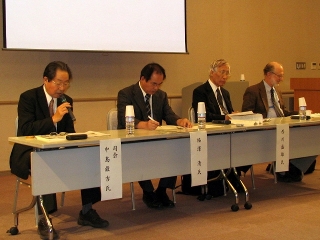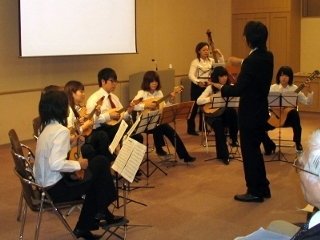Alan Rosen(アラン・ローゼン 熊本大学助教授)
2006年(第8期)市民講座「ハーンを育んだアイルランドの風土と文化」(7回シリーズの第5回)
熊本大学五高記念館
1.General Introduction to the Barrett Collection
The Clifton Waller Barrett Collection is one of the largest and best collections of American Literature in the world. Formerly housed in the Alderman Library of the University of Virginia in Charlottesville (Thomas Jefferson’s University), it is now housed in the university’s new Albert and Shirley Small Special Collections Library. The collection was opened to the public in 1960. Over 1000 authors are represented, and nearly 500 authors have been collected in depth. In total there are over 250,000 individual pieces by and about American writers from 1775 to 1950. Although the Hearn Collection is only a small part of the whole, it forms the most complete collection of original Hearn and Hearn-related materials in the world. Since some of these materials are still unpublished, or published only in part, this collection has become a kind of mecca for Hearn students and scholars. We can see and touch the actual paper Hearn wrote on, letters, manuscripts, and notebooks, and we can have photocopies made from any material that is not too fragile to be handled. Much of the collection has been recorded on microfilm, but much has not. In Japan there are only three places which have microfilm sets of the collection purchased from the Alderman Library: Kobe Shoin Joshidaigaku, Kumamoto Daigaku, and Shimane Daigaku. However, in order to see the real material and the many items not yet microfilmed, you must visit the University of Virginia Library. Once you are there, it is not difficult to see the materials in the Hearn Collection. In fact, the regulations are rather simple and straightforward. There are only three basic rules: 1. Researchers are asked to fill out a brief form and show a photo I.D. (such as a driver’s license, a passport). 2. Only loose paper, pencils, and a laptop computer are permitted in the reading room. No bags, envelopes, folders, notebooks, tablets, or containers of any type are permitted.
Lockers are provided to secure your belongings. 3. Paper is provided by the department for researchers. Laptop computers and other mechanical research tools are permissible provided that their use does not disturb other researchers (from Special Collections Library home page). Before you go into the special reading room with your laptop computer, you simply give your request to the librarian stationed at the desk outside the room. The request is simply a piece of paper stating the name and number of the box of materials that you wish to examine. You can leave the materials in the room when you go for lunch or a break, but at the end of the day all materials must be returned and checked.
When I visited the library several years ago in the summer of 2002, I especially enjoyed looking at Hearn’s manuscript letters and comparing them with the published versions edited by Elizabeth Bisland Wetmore to find the parts that she had omitted. From those manuscripts I was able to find a hidden side of Hearn’s personality that had been cut out from the public portrait of him.
For example, his bad-mouthing of important people and publishers, and his complaints about health or money. Today I would like to introduce the collection and take a closer look at the man who collected it and the story of why and how the collection came into being. In doing this, I hope to give a deeper impression of Hearn’s place in American literature.
2. What is in the Hearn collection?
The Hearn collection includes a wide range of materials by or about Lafcadio Hearn and his writings, both published and unpublished, partly preserved on microfilm, all housed in the same Special Collections Library. The types of materials are:
a. Manuscripts of published works, unpublished essays, and articles
b. Notebooks
c. Letters
d. Newspaper articles by Hearn (Japan Chronicle)
e. Newspaper articles and letters about Hearn and his writings
f. Photos, Fragments, etc.
The Homepage for the Special Collections Library calls it the “Finest Hearn collection ever assembled.” Joan Crane, the Curator of American Literature Collections when the collection was opened, writes:
In the Barrett Hearn collection are the original manuscripts of The Temptation of St. Anthony [Sento Antoni no yuuwaku], Exotics and Retrospectives [Ikoku joucho to kaiko], Kwaidan, and Glimpses of Unfamiliar Japan [Shirarenu nihon no omokage]; fragments of Two Years in the French West Indies [Futsu ryou Nishi indo shotou no ni-nen kan], Youma, Shadowings [Kage], In Ghostly Japan [Reiteki Nippon], Kotto, and Out of the East [Higashi no Kuni Kara]; forty unpublished essays and articles, seventeen notebooks ranging from the New Orleans period to the West Indies to Japan [Internet page says over 30 notebooks], more than 450 letters [Internet page says “nearly three hundred letters&rdquo], and Hearn’s holograph drafts of published articles. Five of the nine numbers of Ye Giglampz, described by Mr. Barrett as a Hearn rarissimum, are present (the only complete set known is in the holdings of the Cincinnati Public Library). The collection of printed works represents every publication: Hearn variant bindings, later editions, periodical printings, translations, inscribed association copies. This part of the Barrett Library devoted to Lafcadio Hearn’s works reflects one facet of Mr. Barrett’s extraordinary accomplishment as a scholarly collector.
In the display of these books and manuscripts at the Alderman Library of the University of Virginia, it is our purpose to draw back the attention of students, scholars, teachers, and readers to a figure in the literary history of this country whose importance has become obscured.
3. Who was Clifton Waller Barrett?
Clifton Waller Barrett was born in the US in 1901. Barrett graduated from the University of Virginia, Class of 1920 at 19 years old. He became chief executive of the North Atlantic and Gulf Steamship Company, Inc. During WWII he was Director of Sugar Transportation for the War Shipping Administration. He was a great reader and book-lover, but he started collecting books rather late [at 38 years old in 1939]. Even so, by 1950 he had a personal library that was considered outstanding among book-lovers in the US. Throughout his life he continued to spend a large part of his fortune on literary materials, slowly building up an outstanding collection of American literary material, including lesser-known writers along with the works of those who were already famous. He gave his entire collection to the university he loved, his alma mater, the University of Virginia.
He continued to support the library’s acquisition of rare American literary materials until he died.[From “A Brief Account of The Clifton Waller Barrett Library” Charlottesville, The University of Virginia, 1960, by Herbert Cahoon, Curator of Autograph Manuscripts, The Pierpont Morgan Library]
4. Why and how did the collection come into being?
We have the words of Mr. Barrett himself to tell us the details. “In 1939 … I [Clifton Waller Barrett] decided to amass a comprehensive collection of American literature-first editions and original manuscripts of American writers from the beginning of the Republic in 1776 to the present day. … Acquiring these milestone’s of a nation’s literary life became a full-time occupation. I retired from business to carry it forward….
At first, my efforts were devoted to forming collections of the great figures of American literature: Walt Whitman, Herman Melville, James Fenimore Cooper, Mark Twain, Poe, Longfellow, Emerson…. Early on, however, I began to realize the importance of so-called minor writers who fleshed out and formed the underpinnings of the nation’s literature….One writer who stood out in this group was Lafcadio Hearn.
His amazing originality, combined with the unusual beauty and quality of his writing had won praise from discriminating critics; however, in the years of World WarII and the decade following he was neglected. When I started to collect his works they were in modest demand, though prices of available material were quite high-due perhaps to his emergence as a cult figure and to the paucity of items on the market. My first purchase was … Some Chinese Ghosts (Boston 1887). I read these tales with increasing pleasure and immediately decided to collect more of Hearn. Soon, a respectable assemblage of his printed works was gathered, but little manuscript material was available aside from the occasional letter at auction which I added to my hoard. Influenced by accounts of this strange romantic life, I resolved to build a representative collection of Hearn’s printed works and original manuscripts most particularly.
My quest took me to Cincinnati and later to Japan, but the first rich strike came on a trip to New Orleans in 1954…. I visited many bookshops on Royal Street and lingered in an old print shop where the proprietor, learning of my interest in Lafcadio Hearn, advised me to call on a lady in the city who was the great-niece of Miss Leona Queyrouze, a Creole poet of New Orleans with whom Hearn enjoyed a platonic affair. [Barrett met her and purchased a signed copy of Some Chinese Ghosts, an inscribed-by-Hearn photo, etc.] When I returned to New York with these exciting documents and memorabilia, I quickly let it be known to various book sellers that I was definitely in the market for Hearn material. John Fleming, bless him, came to my office with a list of original Hearn manuscripts that had languished in Dr. Rosenbach’s vault for years. [Dr. ASW Rosenbach of Phila., whose house is now a modest but well-known museum in Phila.. It houses, eg., manuscripts for such outstanding literary works as James Joyce’s Ulysses, Charles Dickens’ Pickwick Papers, and Joseph Conrad’s Lord Jim.] These were principally manuscripts of Hearn’s Japanese books…. Needless to say, they were a major acquisition.
Some years passed before other important material was forthcoming. [Through the James F. Drake bookshop in NYC, Barrett purchased a large collection from Mr. Leon Godchaux (the Sugar King of Louisiana), a New Orleans native working for the Illinois Railroad who had spent many years collecting Hearn.]
The extent of the collection overwhelmed me as box after box arrived. More space would clearly be required to house it. [He rented an entire floor of a building on 46th St. New York City to keep the new books and materials.] … By serendipity and a series of fortunate coincidences, it had been possible to acquire a great collection of printed works and original manuscripts left by an extraordinary literary and artistic genius, Lafcadio Hearn.”
(From “On Collecting Lafcadio Hearn” by Clifton Waller Barrett, 1983)



